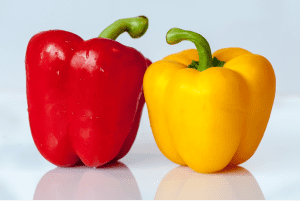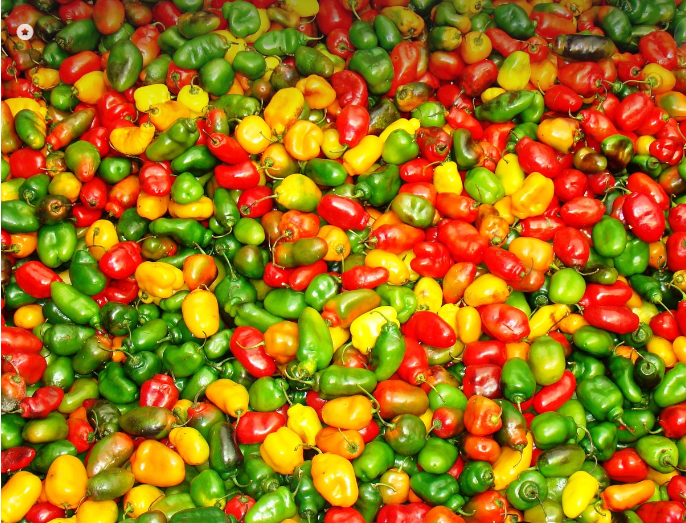Preferred Botanical name: Capsicum Annum.
Preferred Common Name: Bell pepper or sweet pepper.
Local common names;
- Ibibio: Ntuen, Ntokon.
- Yoruba: Atarodo
- Igbo: Ose
- Hausa: Barkono
International common names;
- English: Bell pepper, Chilli pepper, etc.
- Spanish: Chile dulce, pimento etc.
Origin Of Pepper
Pepper or Bell pepper, also known as sweet pepper with capsicum annum’s botanical name. Pepper has its origin in the western hemisphere and appeared for the first time, in South America and Mexico. There are different kinds of peppers, and the type of pepper and where it is grown determine its name.
Variants of ” spicy ” pepper are commonly called chili peppers, or simply “chilies,” while those mild or sweet ones are called red pepper, green pepper, bell pepper, etc. Bell peppers are a perennial crop in tropical areas. But in colder regions, they are grown as an annual crop because they do not tolerate cold weather.
Peppers are used as a food, condiment, and spice to prepare different delicacies today, mostly to achieve a mild or very hot taste. Africans have different varieties and names of pepper; this includes tatashe in Nigeria, the Cameroon pepper, etc.
This article will focus on the species of pepper called the bell pepper. Bell peppers are tender perennials usually grown as annuals.
Nutrient Composition Of Pepper
Bell pepper has water to be about 92% of its composition; however, it also contains some amounts of carbohydrates, proteins, and fat.
- Bell peppers are primarily composed of carbohydrates which contain up to 6 grams of carbs in every 100 grams of bell pepper. The carbohydrates are mainly fructose and glucose, which are naturally occurring sugar.
- Bell Pepper is low in fat, and the fat is mostly polyunsaturated fat which is not harmful to the body.
- Bell pepper is classified as a vegetable, and like other vegetables, it has a small amount of protein. However, bell pepper contains many vitamins, including Vitamin C, Vitamin A, Vitamin B6, Vitamin E, and Vitamin K.
100 grams of raw, red ball pepper will consist of the following nutrient:
- Calories: 31
- Water: 92%
- Protein: 1 gram
- Carbohydrates: 6 grams
- Sugar: 4.2 grams
- Fiber: 2.1 grams
- Fat: 0.3 grams
How To Grow Pepper
Below are the requirements on how to grow pepper
Medicinal Properties And Uses Of Pepper
Bell pepper has proven to be useful as it has a lot of health benefits and medicinal purposes. Below are a few:
- Red Bell pepper helps prevent deficiency of iron which causes anemia. It has Vitamin C, which facilitates the absorption of iron.
- Bell pepper contains a high portion of Lutein and Zeaxanthin, which is good for eye health. Therefore, consuming pepper can improve eye health.
- Pepper contains antioxidant and anti-inflammatory nutrients, which reduce the risk of cancer.
- Research has shown that the flavonoid present in pepper can help to reduce the risk of coronary heart disease.
- Vitamin E is essential for healthy skin. Bell pepper contains a good amount of Vitamin E, which is very good for healthy skin.
- The Vitamin C content in bell pepper helps strengthen hair follicles and build a strong immune system.
Yield Information Of Pepper
Bell pepper requires a fairly long growing season, usually between 90-100 days, about 13-15 weeks, or 3-4 months.
- The period from planting to fruiting bell pepper is about 60-90 days; this is the period from planting seedlings, seed germination, growth phase, and fruiting.
- The period between fruiting and fruit maturity is about 10-15 days, starting from the 80th day of growth to the 100th day; this is to achieve a full and well-grown bell pepper ready for harvesting.
After this harvesting process, it takes time before new fruiting occurs in the already grown pepper stand. The yield per stand of bell pepper is about 20-40 pepper per stand. No artificial fertilizers, pesticides, or fungicides are used; purely natural and organic processes.
In a lifetime, depending on how long the pepper is allowed to grow, the bell pepper can be fruit two or three times, depending on if it is planted as an annual or perennial crop. You can know the yield by considering how many pepper plants are cultivated, the period of cultivation, and the environmental condition.
Nursery And Transplant Requirements Of Pepper
Planting pepper directly into the field is not usually recommended due to the pepper’s specific conditions to germinate properly. Some of the disadvantages of direct planting include:
- Direct seeding makes weed control to be much more difficult.
- Specialized equipment is required to ascertain the depths to prevent seeds from being washed away or buried too deep.
Typically, bell peppers of about 5-6 weeks are being transplanted. Just like other vegetables, container-grown transplants are preferred. Keep soil at 5.5 to 6.5. Full sun, loamy, rich, and well-drained soil is required with plenty of organic components. Avoid sites that tend always to be wet because pepper does not grow well in cold conditions.
Set transplant as soon as possible after removing from the container or pulling. If it is necessary to hold it for a more extended period before transplanting, keep the transplant at a temperature cool enough not to allow the roots to dry out. When setting plants, place roots 3-4 inches deep this helps enhance plant growth and airline.
However, pepper can also be grown in a raised-bed system where the appropriate soil requirement for pepper growth is being used to ensure total yield.
Watering Requirement Of Pepper
Bell pepper requires deep watering at least once a week. Although bell pepper likes warm weather, it will not flourish in intense heat. Overwatering can also suffocate the roots and lead to blossom end rot. Monitor your watering and keep it as balanced as possible.
Planting Requirement Of Pepper
Plant peppers with a spacing of 18-24 inches. If planting on a raised bed, you can grow one plant row per 0.8-1.2m wide bed or two plant rows per 1.5-1.8 wide bed with an in-row plant spacing of 18-24 inches; this is to avoid overcrowding and allow each pepper plant to grow and flourish comfortably.
Soil And Sun Requirements Of Pepper
They requires full loamy soil with good organic composition. The soil should be well-drained and kept at a pH of 5.5 to 6.5. Components of soil needed for bell pepper growth include phosphorus and calcium; they are vital nutrients required for bountiful pepper harvest.
A soil consistency between sandy and loamy ensures the soil drains well and warms quickly. Pepper also requires full sun to grow sufficiently.
Harvesting Of Pepper
Bell peppers are ready for harvest in 70-100 days after. Bell peppers mature from green color to red color as the seeds inside mature. The color change can be slow when the weather is not consistent, resulting in orange-colored pepper.
Harvesting is done by hand picking or cutting pepper off the plant with scissors or garden shear leaving a short amount of stem attached to the pepper.
Storage And Preservation Of Pepper
You can store pepper in a cool, moist place for about 14-21 days. It can also be refrigerated for up to 10 days; place them in a plastic bag while refrigerating to avoid cold burns. Pepper can also be dried or kept in vinegar, or in pieces, or kept in its fresh form.
Pests And Diseases Of Pepper With Their Control
Many pests and diseases affect pepper, of which few will be discussed below.
Anthracnose Colletotrichum spp.
Anthracnose Colletotrichum spp. is a fungal disease that affects pepper. It causes circular lesions on fruits that contain orange or black concentric rings. You can manage the disease naturally by planting disease-free seeds and transplants.
Seeds can be freed from infection by treating with water of about 52 degrees for about thirty minutes.
Cercospora leaf spot
A fungus causes this, and its symptoms are the formation of small circular spots on leaves. The spots mature to develop a water-soaked outer edge. Remove and destroy crop debris to manage it.
Damping-off
This situation does not allow seeds to germinate. Seedlings collapse and die, and the roots are water-soaked and discolored. This disease can be prevented naturally by good drainage and using raised beds to help in irrigation.
Southern Blight
Fungi causes it. Symptoms include the sudden wilting of leaves, yellowing foliage, and brown stem. It can be managed naturally by removing infected plants; the peppers plant spaced appropriately to avoid overcrowding.
Bacterial canker
Bacteria cause it, and symptoms are small lesions on leaves that grow larger. You can manage it by treating seeds with hot water before planting to kill bacteria.
Bacterial wilt
A bacteria causes it, and this causes the upper part of the plant to wilt on hot days and recover in the evening or morning. Vascular tissues in lower stems are often brown. It can be managed naturally by proper spacing, ensuring irrigation, and planting disease-free seedlings.
Aphids
Insects such as aphids, usually green in color, also affect pepper. If its infestation is heavy, it may cause leaves to become yellow. You can naturally check it by using water jets to knock off aphids from plants, handpicking, and killing.
Leave Rollers
These insects roll leaves of plants together and tie them with silk webbings, and they feed damage to rolled leaves, causing defoliation of plants. An insect called leave roller causes it. You can manage naturally by monitoring plants for infestation.
Remove weeds to avoid them acting as a host for this insect. Avoid planting pepper in areas where a host of these insects are found.
Pepper Weevil
They cause feeding damage to the foliage, buds, and tender young fruit pods. Buds and fruit may drop from the plant. Insect causes it. Manage the situation naturally by removing all nightshade plants growing close to the pepper. Also, immediately remove any fallen fruit from the soil surface.
Conclusion
Bell peppers are a nutritious addition to your diet, offering numerous health benefits. Essential vitamins, especially vitamins, enhance resistance to the disease, help prevent it, enhance overall well-being, cause ntooxes, etc., enhance residents, etc. In vegetable form lower down the skeler, it is low in fat and high in fiber , which aids in weight loss and digestive health.
Bell Pepper also contain folate, which is essential for cell division and prevention of certain birth defects. In addition, they contribute to eye health due to the presence of lutein and zeaxanthin. Adding potatoes to your diet can boost your nutrition and help lead a healthy, balanced life.
For more plants information click here

